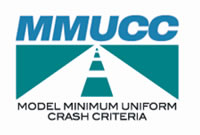NHTSA makes a number of resources available for states and the public on its website, including program guidance, assessments, technical assistance and information about its traffic records program.
The Model Minimum Uniform Crash Criteria (MMUCC) is a minimum, standardized data set for describing motor vehicle crashes and the vehicles and persons involved. By providing a "minimum" set of data elements, MMUCC helps states collect reliable crash data, effectively guide enforcement planning, and shape sound traffic safety policy. This data set, originally published in 1998, has been revised four times, most recently in the 6th Edition (2024), in response to emerging highway safety issues. GHSA has helped manage these updates with funding from the National Highway Traffic Safety Administration (NHTSA).
- MMUCC 6th Edition Update - released January 2024
Prior Editions
The Governors Highway Safety Association (GHSA) and the National Highway Traffic Safety Administration (NHTSA) previously collaborated on prior editions of the Model Minimum Uniform Crash Criteria (MMUCC), most recently the 5th edition.
Feedback from a broad spectrum of MMUCC users was analyzed to develop changes to improve the quality and utility of crash data by addressing emerging safety issues, technological changes in the vehicle fleet, and how states collect, manage and analyze their crash data.
Highway safety professionals provided input on these proposed changes through an online forum (conducted in May) developed by GHSA and NHTSA. An Expert Panel of approximately 30 participants, including representatives of law enforcement, state traffic records coordinators, state and local departments of transportation, researchers, EMS and federal officials, reviewed these comments, and made a number of initial decisions, including the creation of separate sections for fatal crashes, large motor vehicles and non-motorists. It has recommended that states be given more flexibility in the way in which they collect data and has also proposed a few new data elements, including ones for automated vehicles and ignition interlocks. Following the first meeting, the Expert Panel formed small working groups to review particular data elements and their attributes and recommend changes.

